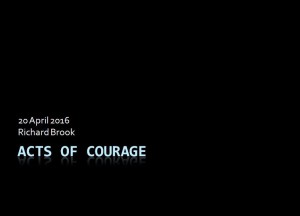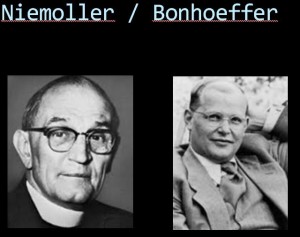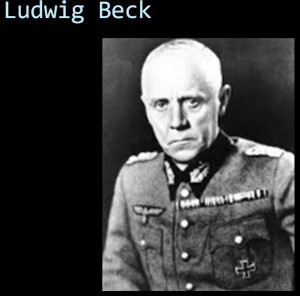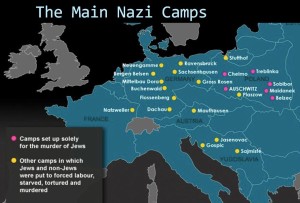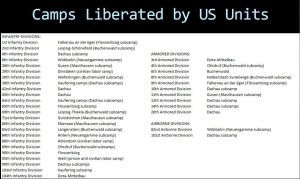Good Afternoon
I’d like to thank the 1st ACB Brigade Command for inviting me here today to attend this program and to give a talk on Acts of Courage during the Holocaust.
Let me first recognize the entire Military Command that organizes programs like this at Ft. Hood and around the country. It’s an honor to be involved. And I want to especially thank you all for your service.
I attended University to study Mechanical Engineering. In my professional life, I earned a living by answering the question…. How does that work? Or How can I make this better?
But I’ve spent a lifetime searching for not just the answer to that question but also the more interesting question of WHY DID THAT HAPPEN? My interest has led me pick away at the historical threads of 20th century military history, slowly revealing one interesting story behind the story behind the story. Inevitably, this has led me to find all sorts of interesting connections and interactions between events. And the more angles from which you view an event, the more likely you are find a hidden truth about that event. This is what fascinates me about history.
Over the years, among my many travels all over the world, I have visited 38 concentration camps. I’ve visited dozens of battlefields from WW1 and WW2 ranging from the UK to Stalingrad. I have visited nearly all of the American Military Cemeteries in Europe and Asia. And because I’m originally from Canada, I’ve visited many of the British and Canadian Cemeteries around the world as well. I gave up counting the number of museums I’ve visited a long time ago. And my bookshelves runneth over.
Somewhere around 6 million Jews were murdered in the Holocaust. What began with public beatings on the street and broken windows ended with piles and piles of ashes. We should not forget that the Nazis murdered other groups as well including the Roma, gays, Jehovah’s Witnesses, the handicapped, as well as millions of Russian POW’s and Poles too. But they had a pathelogical desire to murder Jews.
Resistance to this Nazi effort to murder Europe’s 11 million Jews came in many different forms and by a wide assortment of heroic people. To stand up to Hitler often meant that you were inviting your own death. But people still did it. Their motivations were varied and often very complicated. But they all had one thing in common. They actually stood up when it counted most and did what they could.
Today I’d like to share with you the stories of some of the heroes who did as much as they could and often paid with their lives to thwart Hitler’s desire to murder all 11 million Jews who lived in Europe prior to WW2.
Hitler came to power in 1933 with the promise to stop the chaos in German politics, and to overturn the harsh terms of the Treaty of Versailles which was signed at the end of WW1. Like many politicians, he promised to make Germany great again.
It wasn’t long after he took power that he soon set about trying to murder his political opponents and in June of 1934, about 80 of his rivals in the National Socialist movement were murdered in what became known as the Night of the Long Knives.
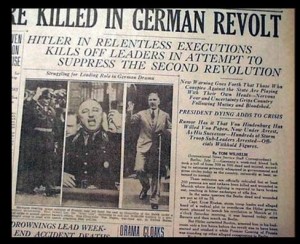
Thousands more were rounded up and thrown in three hastily built forced labor camps. Dachau (outside Munich), Sachsenhausen (north of Berlin) and Neuengamme (south of Hamburg).
This was the start of it all. Jews weren’t the first inmates. It began with the incarceration of Hitler’s political enemies. Some of them were murdered in these camps but most were just forced to break big rocks into little rocks. The Nazis wanted to humiliate them and give them a good attitude adjustment. Most were eventually released once they saw the “error of their ways” and pledged their allegiance to Hitler.
Not long afterwards, roving bands of Nazis then began terrorizing the streets of German cities. Jews, Gays, Bolsheviks and anyone else who pissed them off were also tossed into the growing number of camps going up all over Germany.
Soon the Nazis took over the German churches making it so that all the churches in Germany answered to the Nazi Party.
As a result of its Nazification, a number of Protestant Ministers and Roman Catholic Clergy who rose up in opposition to this plan were also tossed in the camps.
Martin Niemoller and Diettrich Bonhoeffer quit the Lutheran Church over its timid response to this Nazification of their Church. Niemoller got himself immediately arrested. He would spend every day from 1934 to 1945 in either Dachau or Sachsenhausen.
Bonhoeffer joined forces with the organized opposition to Hitler. Not just Bonhoeffer himself but his entire family of brothers and sisters joined the opposition. Before the war ended, Bonhoeffer and his brother as well as 2 of his brothers-in-law, and an uncle were all executed by the Nazis. They were caught in 1944 trying to smuggle 6 Jewish families out of Germany to the safety of Switzerland. They succeeded in getting the Jewish families out but the SS eventually caught up with them and put them to death. .
A number of top Wehrmacht officers tried to depose Hitler even before the war started.
Ludwig Beck served as the head of the German General Staff from 1935 to 1938. (this made him the German equivalent of the Chairman of the Joint Chiefs). A man totally opposed to every aspect of Hitler’s plans from the very beginning, he first tried to thwart Hitler’s efforts to proceed with the Anschluss with Austria in early 1938. But he failed and the Anschluss proceeded anyway. He then tried to outmaneuver Hitler when Hitler decided to invade the Sudetenland. But Beck failed again. He resigned in August of 1938 and was replaced by Franz Halder. Halder also hated Hitler but not quite enough to plot and scheme against him as Beck had.
From 1938 until he took his own life on July 21, 1944, Beck plotted non-stop to try to thwart Hitler.
Beck was directly implicated in the von Stauffenberg Valkyre plan to kill Hitler and rather than give Hitler the satisfaction of shooting him, Beck took his own life the following day.
Had the German opposition, led by Beck, succeeded in killing Hitler in 1942 or 1943, the number of Jews murdered in the Holocaust would have been closer to 1 million, instead of 6 million. But it was not to be.
The fact that they survived in near open defiance to Hitler for as long as they did is a fascinating, complicated and, in many ways, a heroic story.
And speaking of defiance,
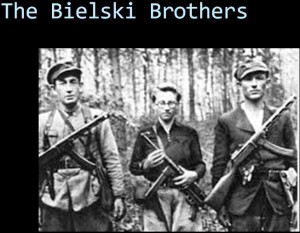
Perhaps you remember the movie titled Defiance about the Bielski brothers that came out a few years ago with Daniel Craig playing the role of Tuvia Bielski and Leev Schreiber playing his brother Zus. When the Nazis attacked east into Russia on June 22, 1941, their parents and several siblings were murdered. But the brothers took to the forest where over the next 4 years they would gather together some 2900 Jews. They lived in the forest and fought as partisans against the Nazis for the duration of the war. At wars end, some 1800 survivors emerged alive after having killed hundreds of Nazi soldiers.
After the war, the surviving brothers moved to New York where they ran a successful trucking company until they passed away peacefully in the early 1990’s. A few years ago I attended a talk given by Tuvia’s son and he told a very funny story. Of course you can imagine that having Tuvia Bielski as a father made it difficult for his son, Zvi, to impress his Dad. Zvi moved to Israel after high school and joined the Israeli Army and became a paratrooper. After he received his jump wings he went on leave and returned home to visit his family. When he proudly showed his father his jump wings his father looked up over the newspaper that he was reading and said to him, “what’s the big deal, they gave you a parachute didn’t they?”.
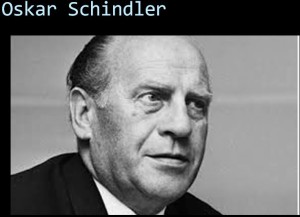
You may also know the story of Oscar Schindler. Schindler was a German from the Sudetenland part of Czechoslovakia. When the war began, he opened a factory to make enamel coated metal pots for the German Army with the labor supplied by hundreds of Jews that he took from the Plaszow concentration camp near Krakow. At the end of the war, Schindler had saved about 1200 Jews from certain death. Over the years, these 1200 people went on to have lives, marry and have children. The list of their descendants now exceeds about 15,000 individuals.
A number of foreign diplomats working in Europe also became heavily involved in saving Jews from the Nazis. Two of the most famous ones were Raoul Wallenberg and Chiune Sugihara.
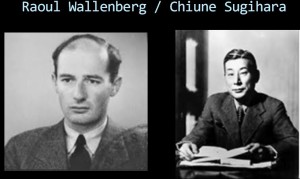
Wallenberg saved tens of thousands of Jews while acting as Sweden’s special envoy to Hungary. In the months between July and December of 1944, totally on his own and against the wishes of the Swedish government, he started issuing bogus protective passports. These passports allowed thousands to take shelter in buildings in Budapest that he unilaterally designated as part of the Swedish consular offices. By doing so, all the occupants of official Swedish Consul Offices were beyond the reach of the fascist Arrow Cross government that had begun deporting Jews to Auschwitz at that time. 400,000 Hungarian Jews were deported to Auschwitz and murdered during this period but as a result of Wallenberg’s efforts as many as 100,000 were saved. Unfortunately when the Russians occupied Budapest in early 1945, Wallenberg was arrested by the NKVD, the Russian secret police. He disappeared and was never heard from or seen again. Tom Lantos, a Congressman from California and one of those saved by Wallenberg saw to it that Wallenberg was made an honorary US citizen.
Sugihara was a Japanese Vice-Consul for the Empire of Japan in Lithuania at the beginning of the war. He began printing bogus transit visas for more than 6000 Jews so that they could leave Lithuania and make their way to Japan. He did this at obvious great risk to himself and his career as the Japanese government was totally in the dark about Sugihara’s activities. Each visa allowed an entire family to transit Russia and make their way to Japan. They travelled by train to Vladivostok and then to Kobe by ferry. When they all started showing up in Japan, the Japanese government had no idea what was going on. Japan was not known as a welcoming place for immigrants and certainly not for European immigrants. They decided to deport most of them to Shanghai where they lived out the war safe from the Nazis. The descendants of Sugihara’s 6,000 families now number more than 50,000 people.
Another hero to be celebrated is Sir Nicholas Winton from London.
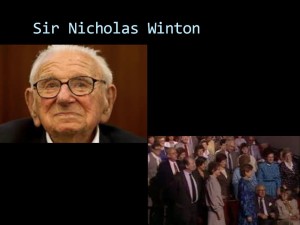
As a young man in 1938, Winton took a ski vacation to Switzerland. When he arrived there, he received a phone call from a friend, Martin Blake, who was in Prague at the time working on the British Committee for Refugees. At this point in 1938, Czechoslovakia was being occupied by the Nazis and it was pretty clear that the local Jewish population was now in grave danger. Winton agreed to travel to Prague to help. A week later Winton had quit his job at an accounting firm in London and went to work full time trying to figure out how to rescue as many children as he could by arranging transport from Prague to England. It was no easy task as the British government required that each child have a financial sponsor before they would issue out a visa in the child’s name. These kindertransports, as they were called, only ended when the war started on September 1, 1939 at which rail travel between Prague and Holland was no longer possible. By that time, Winton had rescued some 700 kids, all who survived the war.
After the war Winton just went back to work as if nothing had happened and never sought recognition for his accomplishments. He got married after the war but somehow never managed to tell his wife Greta about his pre-war exploits. In fact, he never told anyone. The story only came to light in 1988 when Greta just happened to accidentally open a chest in the attic of their home. In it, she found detailed records of all the kid’s names, and their parent’s names, and the names of the families that had taken in the kids. When she asked Nicholas about it, he shrugged his shoulders and just said that it seemed like the right thing to do at the time. Unbeknownst to Nicholas, that wasn’t good enough for Greta. She gave the records to a holocaust researcher in England who tracked down as many of the kids as she could find. Later that year, the Winton’s received ticket’s to attend the taping of a BBC television show called “That’s Life”. He thought he was just going to be in the audience to watch them tape an episode of one of his favorite shows.
As the show began, Winton was shocked to find out that the host of the program was talking about him. At one point, she asked whether anybody in the audience owed their life to Winton and if so, to stand up. About 30 people seated around Winton suddenly stood up and began applauding. It was the first time that Winton ever met any of those that he’d worked so hard to save.
In 2003, Nicholas Winton was knighted by the Queen for his heroism. He only just died last year in July at age 106 after he’d become known as the British Schindler.
Most recently I read the story of an American soldier, Master Sergeant Roddie Edmonds from Knoxville whose heroism was only recently recognized.
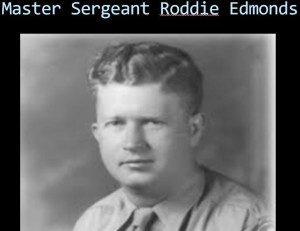
The Master Sergeant was captured during the Battle of Bulge. He found himself to be the highest ranking American among a large group of hundreds of POW’s being held by the SS. While the group was assembled in front of an SS officer for inspection, Edmonds was told by the SS officer to order all the Jewish soldiers to step forward and identify themselves. Rather than give such an order, Edmonds instead ordered every soldier to take a step forward. He then told the Nazi officer that everyone was Jewish. The Nazi became enraged as obviously this could not be true. He pulled out his Luger and put it to Edmond’s head. Again he demanded that Edmonds order the Jewish men stop forward. This time Edmonds is said to have responded by telling the commandant, “If you shoot, you’ll have to shoot us all”. Exasperated, the Nazi officer finally gave up and stormed off.
There were around 11 million Jews in Europe before the war began. The Nazis murdered some 6 million of them.
And in Jerusalem there is a museum dedicated to the holocaust. It’s called Yad Vashem. Since it opened in the 1960’s Yad Vashem has honored the thousands who stood up as Heroes during the Holocaust. Today, roughly 26,000 individuals are recognized as being “Righteous Among the Nations”. These 26,000 saved perhaps a million.
So the pre-war count was 11 million. 6 million were murdered and the 26,000 honored at Yad Vashem saved 1 million more. That leaves 4 million who also survived.
So who do you suppose saved these people?
Had the Germans won the war, it would not have been 6 million murdered Jews. Instead it would have been all 11 million and let’s not forget that once they finished with the Jews, and the Roma and all the gays, they had every intention of also getting rid of millions of Poles and many others as well.
When the allies invaded North Africa in November of 1942, they might not have realized it at the time but there were around 500,000 Jews taking refuge there. Some six long months later, on the 13th of May of 1943, the final Germans in Tunisia surrendered. They didn’t surrender without a fight. Had the allies lost that fight, the 500,000 Jews in North Africa would have certainly been murdered.
The same is true in the rest of Europe. The slaughter in the deathcamps in Poland was only ended when Russian soldiers liberated each camp one by one. And in the West, as US forces allied with British and Canadian forces fought their way across France and into Germany, the slaughter occurring in each German concentration camp came to an end only on the day the camp was liberated.
After D-Day, British and Canadian forces headed north towards Holland. The two camps in Northern Germany, Neuengamme and Bergen-Belson were liberated by them.
In the East, the Russians fought their way to Berlin, liberating all the camps in Eastern Europe. They made it was far west as Ravensbruck and Sachsenhausen.
When the US Army fought its way out of Normandy, it headed north, south and east fighting its way across France and through Germany, into Austria and all the way to Plzen in Czechoslovakia. All the rest of the camps that you see on this map in France, Germany and Austria were liberated by US Forces.
What this map doesn’t show you are the thousands of sub-camps that the Nazis operated.
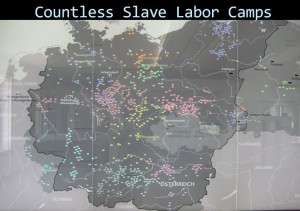
The sub-camps were typically located at German companies. And there were thousands of them. With all the men either volunteering or conscripted into the Germany military, German industry needed slave laborers to operate. Conditions were awful and hundreds of thousands were literally worked to death.
I thought it would be interesting to show you a list of the camps liberated by various Divisions.
The list is from the National Holocaust Museum in Washington which began recognizing these different US Commands about 10 years ago. The list has been expanding as more information becomes known. With thousands of sub-camps liberated by the US Army, there is a long way to go before they get a complete list.
I want to tell you about a couple of these divisions and the camps they liberated. The 90th Infantry division liberated Flossenburg in late April of 1945. 30,000 people were murdered there. Flossenburg was built at a granite quarry and the inmates were forced to mine the granite which was being used by the Nazis all over Germany to build monuments to themselves.
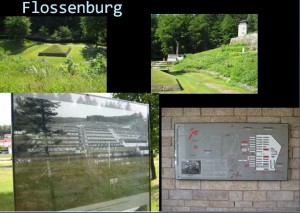
When the 90th Infantry arrived, they found dead and starving inmates all over the camp. The guards had all disappeared as they had left the camp the day before, forcing the remaining 6000 inmates who could still walk on a death march heading south towards Dachau. The camp sits just above the town of Flossenburg but when the commanding officer of the 90th, Brig. Gen Jay McKelvie, sent his men back down the hill and into he town looking for those responsible for the camp, every single person in town denied any knowledge of the camp’s existance. McKelvie who had been walking around the camp inspecting the carnage, became incensed, declared Marshall Law and forced the people from the town to gather up the hundreds of dead bodies and carry them down to the center of town where he forced them to bury them properly. The cemetery that he created that day still sits in the middle of the town.
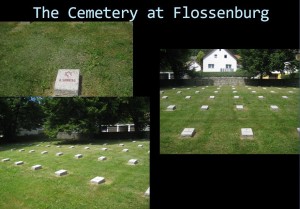
There is a Holocaust survivor who now lives in Dallas who I met some years ago. His name is Max Glauben. Max speaks about his experiences all over Texas. He was one of the group of people forced to march out of Flossenburg towards Dachau the day before the 90th arrived. He was liberated when a column of GI’s came around the bend in the road and found themselves in the middle of this group marching south. The German guards all ran away and Max’s nightmare was over.
To Max, everyone of those GI’s was a hero. They almost certainly saved his life.
Another camp liberated by US forces was Mittelbau Dora.
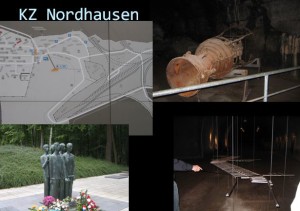
Werner von Braun, Arthur Rudolph and dozens of other Nazi scientists were building V1 and V2 rockets on an island off the north coast of Germany called Peenemunde. The rockets that they built were raining down on London, killing thousands. To try to end the carnage, in August of 1943, over the course of two nights, the allies sent two, one thousand plane bombing missions to Peenemunde in an attempt to wipe out the factory.
The only way to continue production was to move underground. So, the factory was moved to the town of Nordhausen. Two tunnels, more than a mile long, were dug with slave labor into the Hartz Mountains. Thousands died digging the tunnels and thousands more died building the rockets once production resumed.
Elements of the 3rd Armored Division liberated this camp. As with Flossenburg the prison guards all took off the day before 3rd Armored arrived marching the remaining inmates who could still walk, in this case some 2000 nearly dead souls, east from the camp heading towards Berlin. The US Army caught up with them a few days later. The night before the Army arrived, the Germans herded all 2000 into a barn near a town called Gardelegen and lit the barn on fire. Only a few survived.
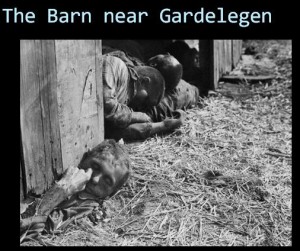
General Frank Keating, upon seeing the mass murder at the barn entered the town of Gardelegen and in a repeat of what happened at Flossenburg, he forced the local townspeople to give the bodies a proper burial in a cemetery that to this day is still tended to by the town. .
It was Winston Churchill who said when the war started, “Herr Hitler has chosen the time and place to fire the first shot. We will choose the time and place to fire the last.”
There were a lot of heroic people who risked much during the Holocaust in an attempt to make a difference. Some of their stories are pretty straightforward and some are pretty complicated. But they all committed heroic acts to help save lives and they often paid with their own.
In the final analysis it was victory that finally stopped the Holocaust. A victory only made possible through the tremendous sacrifices of the men and women of the allied Armed Forces. Your efforts today and everyday, keep us all safe.
You, and those who served before you, are all heroes.
Thank you.
